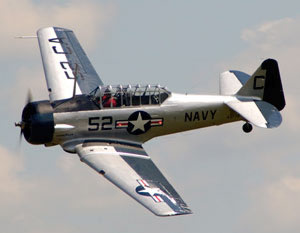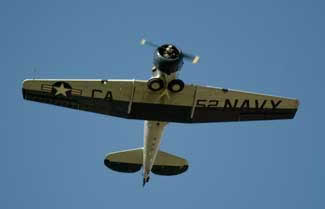Navy Aerobatic Air Shows
Presented by Warbird Aviation Rendezvous, Inc.
Overview of the SNJ-5 | 43779's Career
|
"In order to evaluate this scheme under various conditions CNATRA on June 13, 1952, directed that twelve SNJs of Basic Training Unit 1 (BTU-1) at NAAS Whiting Field, twelve SNJs of BTU-2 at NAAS Corry Field, and twelve SNB-5s assigned to US Navy School All Weather Flying (USNSAWF) at NAS Corpus Christi used for instrument training were to be painted with this high visibility scheme. In addition, three SNB-5s at Corry Field used for instrument training were to be painted glossy yellow for comparative purposes."
- THE OFFICIAL MONOGRAM US NAVY & MARINE CORPS AIRCRAFT COLOR GUIDE, Vol. 3 1950-1959, By: John M. Elliott Maj. USMC(Ret) |
Overview of the SNJ-5
(Click Here to Download a Printable Version of this Overview)
Warbird Aviation Rendezvous, Inc., based in  Springfield , Illinois , owns and operates a 1943 North American SNJ-5 licensed in the standard category, bureau number 43779.
Springfield , Illinois , owns and operates a 1943 North American SNJ-5 licensed in the standard category, bureau number 43779.
Clyde Zellers has restored and repainted
this airplane in the unique and accurate paint scheme of Basic Training Unit Two, Corry Field, Pensacola Complex during 1952.
This paint scheme was one of several tested for high visual acuity in the busy training areas surrounding Pensacola , Florida.
43779's Career
(Click Here to Download a Printable Version of this History)
The SNJ-5 flown by NAA has a long and storied career, flying from 1943 through 1958 with the U.S. Navy from Naval Air Stations in Texas, Louisiana, Florida and New Jersey and then civilian ownership since. Warbird Aviation Rendezvous has owned and flown the aircraft since the late 1990's. Here is a history of the veteran’s naval career:
01 February 1944. Aircraft was accepted by the United States Navy
-
02 February 1944. Aircraft was delivered to VN-15 (D-8-A) Kingsville Texas, otherwise known as Training Squadron 15.
-
Training Squadron 15 moved from Naval Air Station Jacksonville in Florida to Naval Air Station Kingsville in January 1943.
-
Kingsville was among the U.S. Navy training facilities located around the Corpus Christi Texas complex during World War II.
Others included: Beeville, Cabiness, Cuddihy, Rodd and Waldron.
-
After the official end of World War II the SNJ was assigned to a pool,

(group of reserve training aircraft), in November 1945 at NAS Cuddihy and remained there until April 1946.
-
During the months of April and May of 1946 the airplane underwent reconditioning at the overhaul repair facility in Pensacola Florida.
-
On 06 June 1946 SNJ-5 Bu.No.43779 was assigned to an aircraft pool at Ellyson Field and the next day, 07 June 1946, was transferred to the storage facility in Houma Louisiana just southwest of New Orleans and remained there until November 1947.
-
Sometime in November 1947 the SNJ was moved from the Houma storage facility to Litchfield Park near Tucson Arizona and remained in storage from November 1947 until February 1952. Litchfield Park was the U.S. Navy’s long term storage facility very much like the U.S. Air Force’s storage center at Davis-Monthan AFB near Tucson as well. Typically referred to as: “The Boneyard.”
-
In 1950 the U.S. Navy adopted a new form of History Card used to track its aircraft disposition. Pilot training procedures changed as well and the SNJ was now used as a beginning or primary flight training airplane instead of an advanced trainer. Naval Aviation Cadets,
(NAVCADS) started out in the SNJ with their first flight lesson.
-
On 13 February 1952 the Navy transferred SNJ Bu.No.43779 to the Overhaul & Repair facility at

NAS Pensacola where it remained to undergo what was probably a very thorough inspection before being released and transferred to BTU-2 at Corry Field on 14 April 1952.
-
During World War II most SNJ training aircraft were painted silver by spraying the aircraft with a mix a silver powder paste and clear lacquer. This was primarily done to aid against corrosion.
Mid-air close calls and training incidents would seem to indicate that a different color scheme be used to make the aircraft more readily visible in the busy training sectors around the training fields.
-
On 13 June 1952 a letter came through channels from CNATRA (Office of the Chief of Naval Air Training) directing that 12 SNJ aircraft from BTU-2 at Corry Field be sent to the paint shop for a unique paint scheme. The 12 airplanes would be painted either White or Silver and the cowling, elevators, rudder and trailing half of the main wing be painted in a Glossy Sea Blue color. Two other training units were involved in this test period for various other paint schemes that would make the training aircraft more visible.
It is hard to estimate exactly when, but sometime after the test paint schemes were evaluated in 1952, the U.S. Navy decided on the color Yellow for the SNJ primary training aircraft paint scheme. Prior to that time period it would appear that not all training aircraft were universally painted in the same paint schemes. SNJ-5 Bu. No. 43779 has been painstakingly painted in the exact color scheme of the test period as this aircraft was assigned to BTU-2 at Corry Field during the time frame of the required test. While it would be nearly impossible to know for sure if this airplane was one of the BTU-2 aircraft involved in the test, it is just as likely that it could have been.
BTU was the designation of the Basic Training Unit or training squadron located at the associated field. This designation later became known as (VT) for the different training squadrons within the U.S. Navy sometime during the late 50’s or very early 60’s.
-
In the month of December 1952 the SNJ was moved back to Overhaul & Repair at NAS Pensacola where it stayed until January 1953.
-
On 29 January 1953 the SNJ was transferred to BTU-1c at Saufley Field. The plane was located at Saufley until December 1953 when it was again moved back to Overhaul & Repair (O&R) at NAS Pensacola (PNS). The records show that this aircraft was in O&R at NAS PNS until 08 April 1954.
-
On 22 April 1954 the SNJ was transferred to HU-2 at NAS Lakehurst in Lakehurst New Jersey. It stayed

with HU-2 until 22 January 1955.
Helicopter Utility Squadron 2, (HU-2) was established in 1948 at NAS Lakehurst. HU-2 was one of the Navy’s first helicopter squadrons.
-
On 29 March 1955 SNJ 43779 was officially transferred to ZP-3 located at the same base, NAS Lakehurst. ZP-3 was an Airship Patrol Squadron flying Blimp type aircraft. The SNJ remained with ZP-3 until 29 February 1956 when it was returned to the O&R facility Pensacola. In September 1962 the Navy decommissioned and deactivated ZP-3.
Typically the Navy would have one or two SNJ aircraft included at a squadron or base so dual rated pilots could maintain currency in a fixed wing aircraft and the SNJ could also be used as a Liaison or small transport airplane.
-
Navy records show that on 29 March 1957 the SNJ was transferred to NABTC (Naval Air Basic Training Command) Corry Field and stayed there until 20 January 1958 where it was once again moved to O&R at Pensacola.
-
U.S. Navy records indicate that this SNJ was retired on 28 April 1958 and stricken from the U.S. Navy inventory.
Fourteen years & three months of service to the United States Navy.






